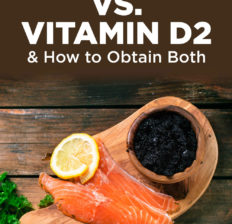This Dr. Axe content is medically reviewed or fact checked to ensure factually accurate information.
With strict editorial sourcing guidelines, we only link to academic research institutions, reputable media sites and, when research is available, medically peer-reviewed studies. Note that the numbers in parentheses (1, 2, etc.) are clickable links to these studies.
The information in our articles is NOT intended to replace a one-on-one relationship with a qualified health care professional and is not intended as medical advice.
This article is based on scientific evidence, written by experts and fact checked by our trained editorial staff. Note that the numbers in parentheses (1, 2, etc.) are clickable links to medically peer-reviewed studies.
Our team includes licensed nutritionists and dietitians, certified health education specialists, as well as certified strength and conditioning specialists, personal trainers and corrective exercise specialists. Our team aims to be not only thorough with its research, but also objective and unbiased.
The information in our articles is NOT intended to replace a one-on-one relationship with a qualified health care professional and is not intended as medical advice.
Vitamin D3 vs. Vitamin D2 & How to Obtain Both
July 31, 2022

Vitamin D3 is one of the most buzzed-about supplements in the health industry. That’s because it’s estimated that over 40 percent of the population is deficient in vitamin D, which plays a role in everything from regulating mood to modulating immune cells.
Not only that, but it’s one of the few nutrients that’s difficult to get from food sources alone, considering our bodies get most D from sunlight exposure.
What’s the difference between vitamin D vs. D3, and what is vitamin D3 good for? Keep reading for everything you need to know about this important micronutrient and how it can impact your health.
Vitamin D3 vs. Vitamin D2
Vitamin D3, also known as cholecalciferol, is a fat-soluble vitamin that is involved in bone health, immune function, cell growth and more. Experts believe we need it to defend against a number of chronic diseases, including heart disease, cancer, inflammation and autoimmune diseases.
Your body is able to produce vitamin D on its own when your skin is exposed to sunlight. It can also be obtained through several vitamin D food sources and supplements.
Unfortunately, vitamin D deficiency is a common issue, and certain groups are at a higher risk of deficiency. In particular, older adults, those who get limited sun exposure, and people who are overweight/obese or have darker skin are at an increased risk.
Vitamin D3 vs. Vitamin D2
What is the difference between vitamin D and vitamin D3?
Vitamin D is available in two forms: vitamin D2 (ergocalciferol) and vitamin D3 (cholecalciferol). D3 is thought to be more absorbable because it’s converted most easily to 1,25-dihydroxyvitamin D, the active form of vitamin D.
Vitamin D3 is primarily found in animal foods, such as fish, liver, eggs and cod liver oil. Meanwhile, vitamin D2 is mostly in mushrooms and fortified foods, such as cereal. Both are also available in supplement form as well.
The biggest difference between vitamin D2 vs. D3 actually lies in the way that they are metabolized in the body. In fact, one study published in the Journal of Endocrinology and Metabolism found that vitamin D3 was nearly twice as effective at increasing vitamin D levels in the blood compared to vitamin D2.
For this reason, it’s generally recommended to select a vitamin D3 supplement over one containing vitamin D2.
Benefits/Uses
1. May Help with Weight Management
Some studies show that vitamin D levels tend to be lower in people with higher amounts of body fat.
Supplementing with vitamin D3 may help enhance weight loss and bump up fat-burning. For example, one study demonstrated that supplementing with calcium and vitamin D increased weight loss and fat loss compared to a control group.
2. Boosts Bone Strength
Vitamin D is absolutely essential when it comes to bone health. In fact, one of the most serious vitamin D3 deficiency symptoms in children is rickets, a condition characterized by a softening and weakening of the bones.
One of the main ways that vitamin D boosts bone strength is by promoting the absorption of calcium, which is essential to maintaining skeletal integrity. Plus, it’s also involved in the metabolism of phosphorus, another key mineral that is important to bone health.
3. Improves Immune Function
One of the most impressive benefits of vitamin D3 is its ability to enhance immunity and protect against infection.
Not only can a deficiency in this important micronutrient slow wound healing and increase the risk of infection, but vitamin D3 is also integral to the function of immune cells in the body.
According to research, lower levels of serum vitamin D are actually associated with the a higher risk of recent respiratory tract infections, demonstrating just how crucial this vitamin is for immunity.
Some experts now even recommend that people who are deficient and at risk for certain illnesses take a high dose of vitamin D3 to quickly raise levels, followed by moderate doses (about 10,000 IU/day of vitamin D3 for a few weeks, followed by 5,000 IU/day).
4. Enhances Mental Health
Some research shows that vitamin D could be beneficial for boosting mental health and brain power. Studies have found that vitamin D status could potentially be linked to issues like:
What’s more, one study conducted by the Washington University School of Medicine even showed that low levels of vitamin D were tied to low mood and impaired cognitive performance in older adults.
5. May Help Fight Cancer Cells
Although research is still limited on exactly how vitamin D3 can impact cancer growth in humans, in vitro research suggests that it may affect several aspects of cancer development, including tumor growth and cell death.
Other studies have found that vitamin D deficiency may be linked to a higher risk of certain types of cancer, including breast, prostate, colorectal, ovarian, kidney and stomach cancers. However, further research is still needed to determine whether other factors may also be involved besides vitamin D3 levels.
Foods
Adding a few vitamin D3 foods to your diet is a simple way to bump up your intake of this important fat-soluble vitamin. Here are a few of the top food sources of vitamin D3:
- Cod Liver Oil — 1 tablespoon: 1,360 international units (over 100 percent DV)
- Wild-Caught Salmon — 3 ounces: 447 IU (over 100 percent DV)
- Mackerel — 3 ounces: 306 IU (76 percent DV)
- Tuna Fish — 3 ounces: 154 IU (39 percent DV)
- Sardines — 2 sardines: 47 IU (12 percent DV)
- Beef Liver — 3 ounces: 42 IU (11 percent DV)
- Eggs — 1 egg: 41 IU (10 percent DV)
- Caviar — 1 tablespoon: 37 IU (9 percent DV)

Supplements and Dosage
Sun exposure is one of the easiest and most effective ways to meet your vitamin D needs. When this isn’t possible, supplementing with D3 is recommended, as well as increasing your vitamin D food intake.
Vitamin D supplements can be a quick and convenient way to meet your needs for this important fat-soluble vitamin, especially if you’re at an increased risk of deficiency.
If you do opt to take one, be sure to select vitamin D3 instead of vitamin D2 to maximize absorption. You should also take vitamin D with meals, as it requires a good source of fat to be absorbed in the body.
You may be wondering: How much vitamin D3 should I take daily? Currently, the recommended dietary allowance for vitamin D is as follows:
- 400 IU: infants 0–12 months
- 600 IU: children and adults 1-70 years
- 800 IU: adults over 70 years
However, many believe that the recommended vitamin D3 dosage should be even higher, and supplements often contain doses of up to 5,000 IU per day. Therefore, it’s best to work with your doctor to determine the right dosage for you to prevent symptoms of deficiency.
Risks, Side Effects, Interactions
Can you overdose on vitamin D3? What happens if you take too much vitamin D3?
Although the upper limit for vitamin D is currently set at 4,000 IU per day, researchers believe that doses of up to 10,000 IU per day can be taken without symptoms of toxicity.
However, it’s important to use supplements only as directed and avoid taking large amounts of vitamin D. Some of the potential vitamin D3 side effects may include abdominal pain, vomiting, nausea and confusion.
If you notice any negative side effects after starting vitamin D3 supplementation, discontinue use, and consult with your doctor.
Finally, be sure to consult with a trusted health care professional before starting supplementation if you have any underlying health conditions. In particular, vitamin D may worsen symptoms caused by issues like kidney disease and hyperparathyroidism, as it increases calcium absorption in the body.
Conclusion
- Vitamin D3, also known as cholecalciferol, is a fat-soluble vitamin that is involved in bone health, immune function, cell growth and more. This is the type that’s most easily absorbed by your body, more so than vitamin D2, which is mostly found in mushrooms and fortified foods, such as cereal.
- Vitamin D3 is primarily found in animal foods, such as fish, liver, eggs and cod liver oil.
- If you don’t get enough sun exposure, supplementing with D3 can help bring your levels up. The recommended daily amount is between 600 to 800 IU per day for adults, although higher doses may be helpful.














